Arsenal Women hosted Liverpool Women last weekend in the FAWSL. Arsenal are in contention for pole position in the FAWSL table along with Chelsea Women and Manchester City Women, while Liverpool have been enduring a poor season and sit at the bottom of the table.
Joe Montemurro’s Arsenal side looks reinforced with quality in the midfield with Jill Roord joining them from Bayern Munich Women and Jordan Nobbs returning from a torn ACL that saw her out for the most of last season. We shall see in this analysis how their midfield looked dynamic in their rotations and positional play, which has become a cornerstone of Montemurro’s tactics at Arsenal. The game ended with only one goal in the first half to separate the two sides despite the hosts looking far more dominant. In this tactical analysis we shall examine closely how both teams played each other out.
Lineups
Arsenal (4-3-3): Manuela Zinsberger, Jill Roord, Jennifer Beattie, Leah Williamson, Katie McCabe, Lisa Evans, Jordan Nobbs, Kim Little, Danielle van de Donk, Beth Mead, Vivianne Miedema
Subs: Lia Wälti, Louise Quinn, Leonie Maier, Viktoria Schnaderbeck, Pauline Peyraud-Magnin, Ruby Grant, Melisa Filis
Liverpool (4-2-3-1): Anke Preuss, Becky Jane, Niamh Fahey, Sophie Bradley-Auckland, Leighanne Robe, Rhiannon Roberts, Jade Bailey, Kirsty Linnett, Rinsola Babajide, Courtney Sweetman-Kirk, Melissa Lawley
Subs: Christie Murray, Ashley Hodson, Niamh Charles, Fran Kitching, Amy Rodgers, Missy Bo Kearns
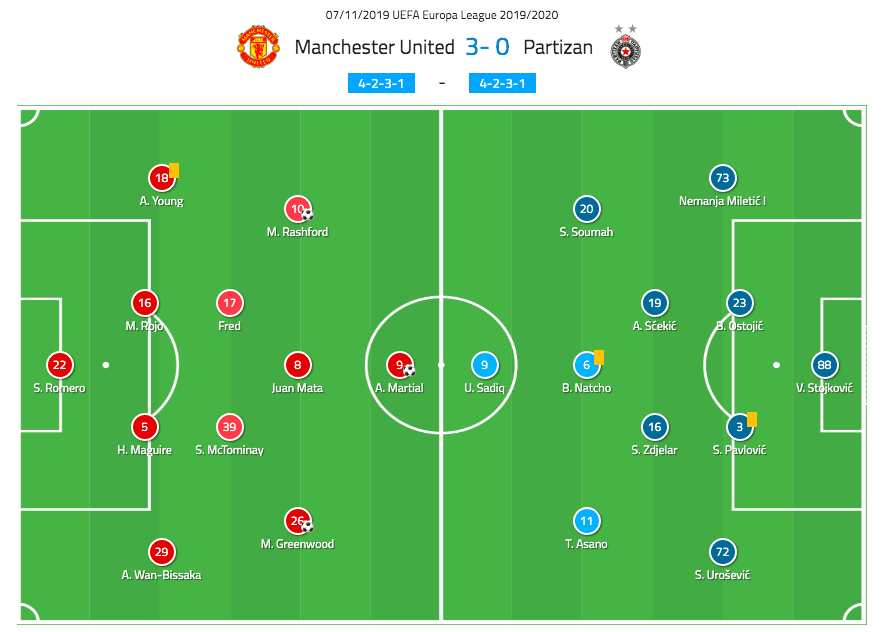
Liverpool defensive organisation
Before we look at Arsenal tactics, let’s go through Liverpool’s strategy for the game. Facing a tough opponent, the visitors expected Arsenal to have a lot of the ball and spend a lot of time trying to keep the ball. They opted for a 4-2-3-1 mid-block to press Arsenal. With a very direct style of play, Liverpool sought to release the forwards early upon winning possession. Throughout the game we could see that once Liverpool won the ball, they would immediately feed it into the wide areas for Sweetman-Kirk, Lawley and Babajide to chase after.
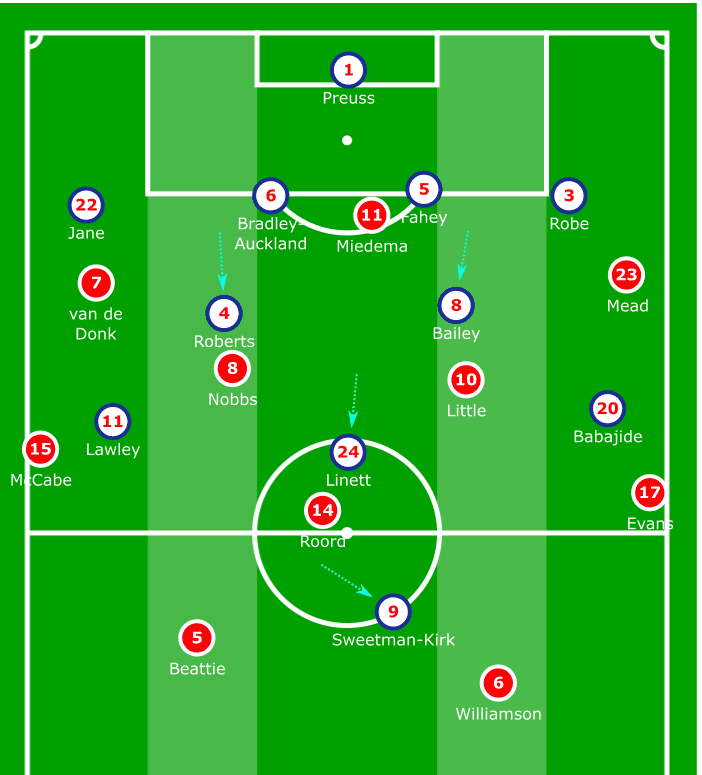
The strategy of having two defensive midfielders, Bailey and Roberts in front of the defensive line was to minimise the space for Arsenal’s technical players to operate and create goal scoring chances. Anticipating that Arsenal will want to circulate the ball a lot, even using their defenders if there was an overload higher up the pitch, Liverpool’s main objective was to push the hosts back whenever they gained an opportunity. Hence we saw this 4-2-3-1 structure always looking to gain a couple of yards when Arsenal played the ball back towards their own goal.
Liverpools tactics only created five shots, two on target in comparison to Arsenal’s 16 shots with four on target. But their organised pressing managed to create problems for Arsenal early on in the game and it was a fingertip save by Zinsberger who managed to keep a shot out with some help from the post from a Liverpool free kick. From that point on, Arsenal managed to work their way back into their game and find their rhythm.
Arsenal attacking organisation
If we look at Arsenal’s 4-3-3 formation, it was a very fluid structure that supported plenty of midfield rotations and movements. In the buildup, we saw Roord and Little taking turns to come short to receive the ball, while Nobbs positioned herself higher between the lines. Van de Donk would regularly drift inside into a central position giving room for the pace of McCabe to attack the left flank and always present a wide option to the structure. On the right side we saw Evans, the right back forming a great partnership with Mead often overlapping or underlapping with her runs and adding an extra attacking player. We also saw the central defenders split wide apart and pick moments to drive forward if there was no passing option, attracting the press and creating overloads in the midfield.
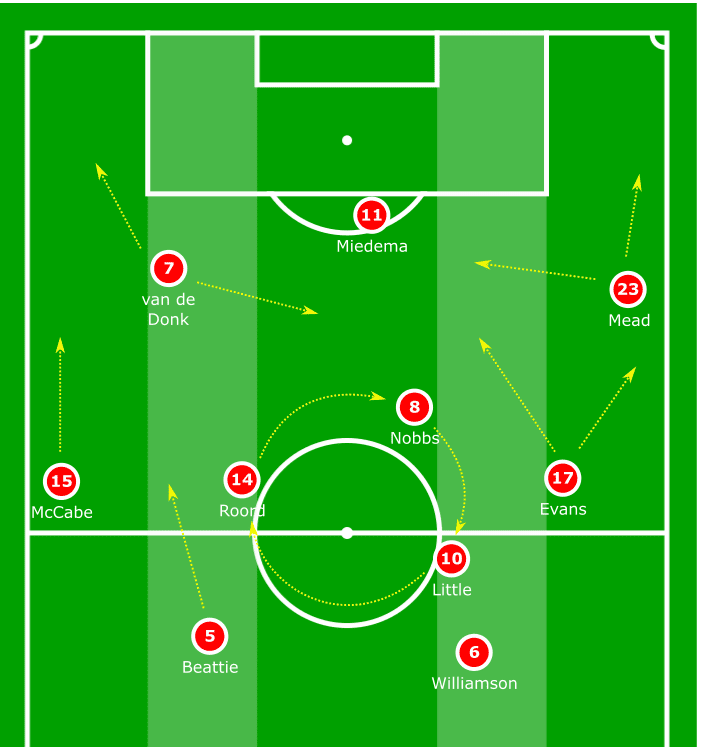
The general underlying principles behind Arsenal’s attacking organisation was to apply pressure high and win the ball early, retain possession using short passes even if it meant circulating the ball back through their defenders, and use of width to stretch the opposition and provide equal threat from both sides. The second most dominant feature of Arsenal’s organisation was their positional play in the midfield. They always prioritised creating superiorities behind opposition lines of pressure and a player like Nobbs was best suited for linking up play in tight spaces.
In this graphic we see Liverpool attempting to play a pass from the back but Arsenal press high. Here van de Donk presses Bailey all the way from her left wing position. She intercepts the ball and immediately plays it to Mead on the right side who is pushing high.
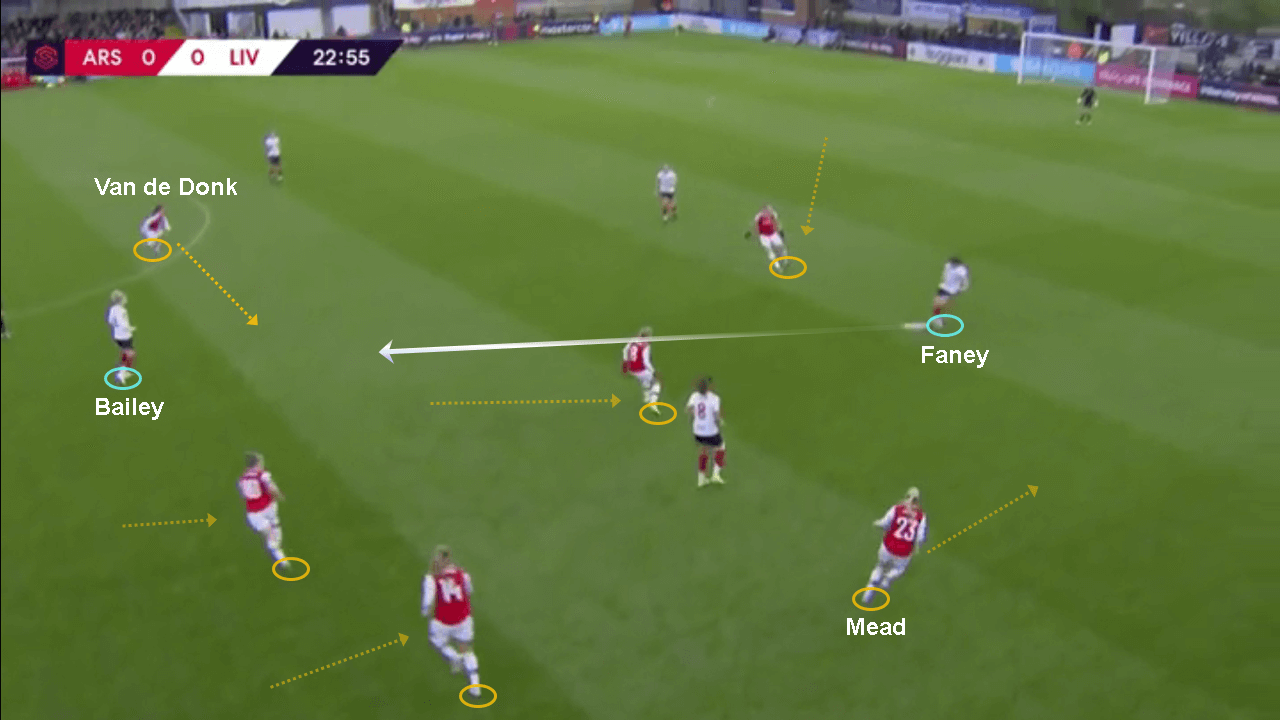
Let us look deeper into the sub-principles of Arsenal’s game model.
Overload and verticality in possession
Arsenal would position their players close to each other to create short passing options. Liverpool’s strategy to press the hosts when they engaged in short passes meant it would create an overload on one side of the pitch. Once there was an overload of players on one side, Arsenal would find a free pass back to their defenders who would switch the point of attack. Zinsberger the goalkeeper often played well out of her box in order to facilitate this circulation through the back as a sweeper. She was well integrated into Arsenal’s formation and created a three-at-the –back structure with Williamson and Beattie.
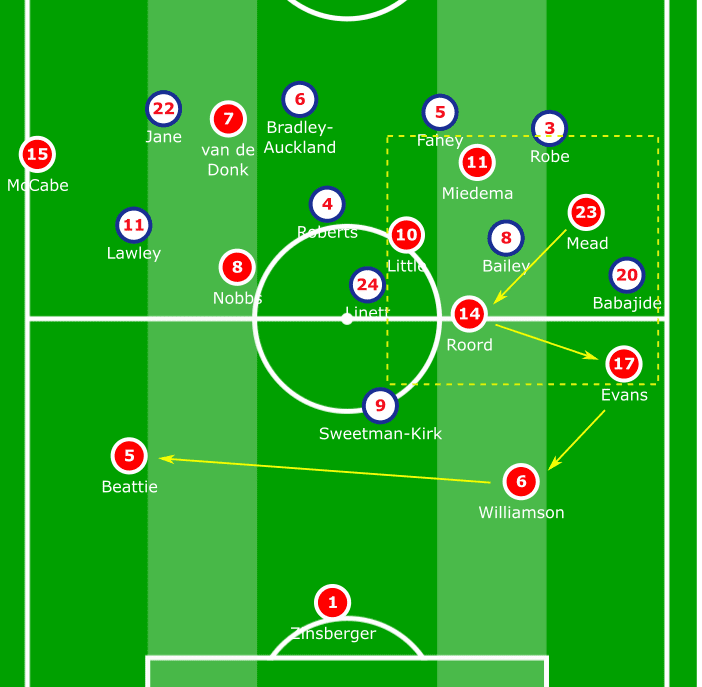
Another sub-principle in Arsenal’s playing style was the use of vertical passing. They always looked for passes through the centre that penetrated lines of pressure. But playing through the centre did not always allow the receiver to receive the pass unmarked, and she often had to play it back. But this allowed movement for third-man runs in another part of the pitch that would allow the team to progress together forward. This meant taking one step back but two steps forward. This tactic was very effective in moving defenders out of possession and creating free passing lanes for the wide players.
Here in this graphic, we see Beattie playing a vertical pass to Roord who receives the pass facing her own goal and is immediately pressured. But if we take a look at Nobbs further up the pitch, we see her already making a movement into space and asking for the pass from Beattie after Roord lays it off to her. Because of this, while the Liverpool defenders are focused on marking Roord, Nobbs manages to find herself free and creates a passing lane for herself. We also see how this move is one step backward, but two steps forward. We saw this kind of movement throughout the game from Arsenal which made their passing very dynamic, fluid and difficult to intercept.
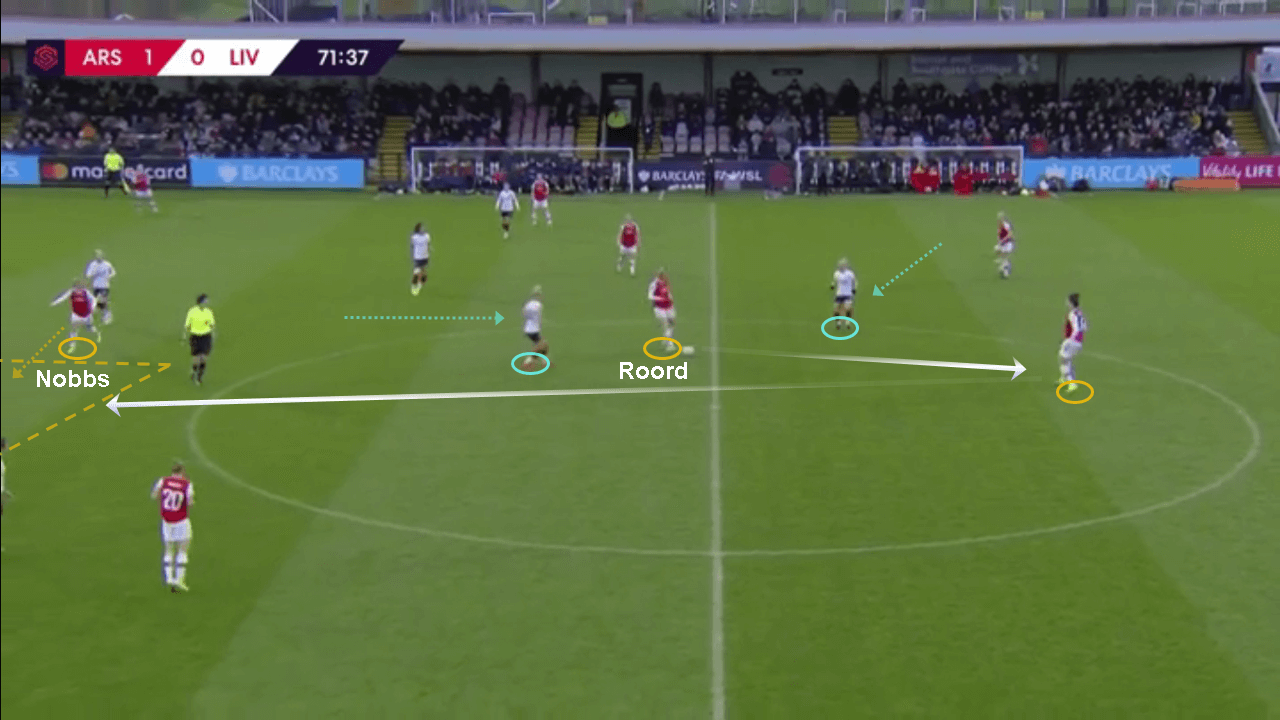
Having midfielders like Roord, Nobbs and Little with excellent positional sense constantly rotating in the centre, Arsenal managed to keep Liverpool pinned back in their structure. They also exploited width in the attack with McCabe and Mead positioned on the far side on either flank. If they ever ran into trouble, they always had their central defenders who were comfortable on the ball to circulate possession and switch the point of attack to another part of the pitch.
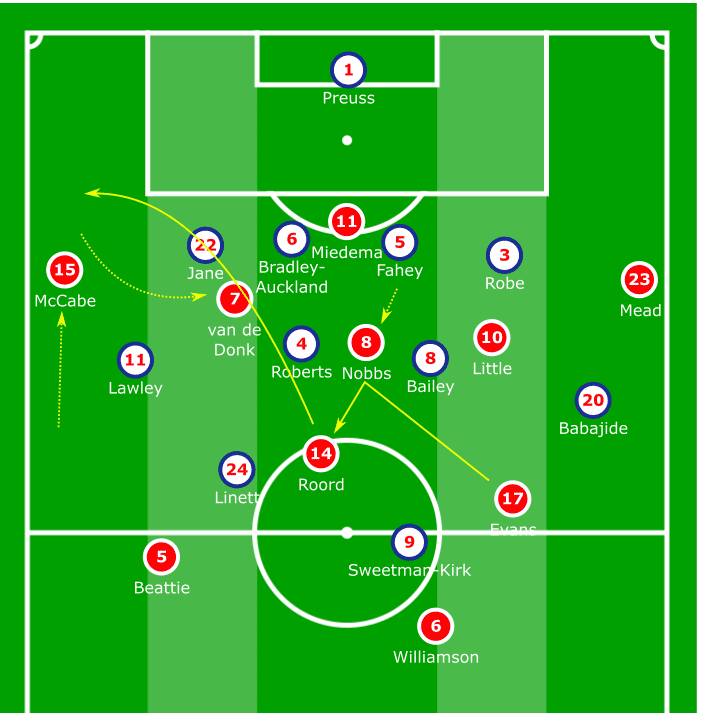
Positional play by Arsenal
We saw the attacking players like van de Donk, Miedema and Nobbs constantly positioned in pockets of space in front of the defensive line and behind the Liverpool midfielders. This positioning was very important as it always forced the Liverpool defenders to stay in their structure to cut passing lanes and keep the back line pinned deep in their own half.
The midfielders and the forwards were very fluid and constantly rotated roles ensuring there were always players in advanced positions. Here we see van de Donk playing very deep having drifted centrally from her initial position as a left winger. Meanwhile Nobbs is positioned between the lines of pressure asking for the ball and Miedema is pinning the defenders back. It was important for Nobbs to stay high and not come closer to support because this keeps the Liverpool defenders occupied deeper in their half.
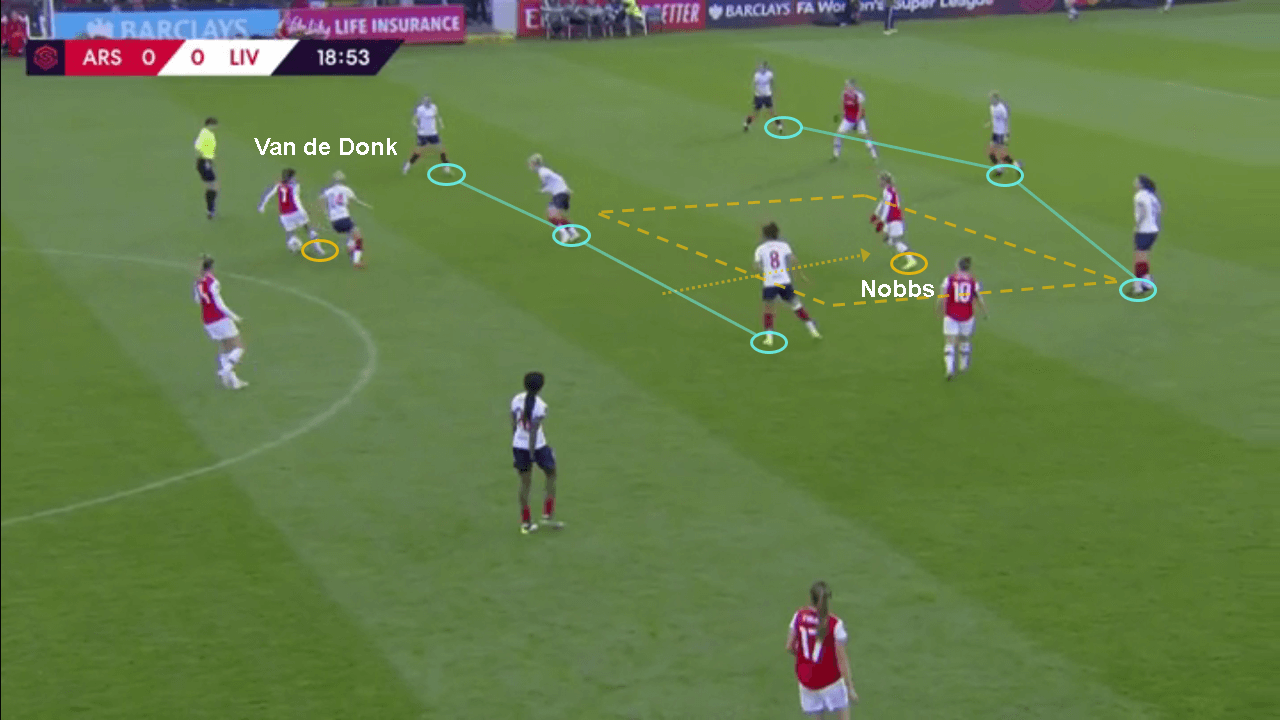
Nobbs’ positioning throughout the game was very intelligent and Arsenal’s game is heavily boosted with her presence after coming back from injury. By finding pockets of space between the lines, she can always ask for the pass and if she finds time and space, can play it out wide and move forward, as we see in this scheme on the left. On the right we see how Miedema drops from a centre forward position between the lines and lays off the pass to Roord who can then distribute it wide to Mead on the right. Thus positional play and vertical passing formed the pillars of Arsenal’s attacking organisation that helped them dominate the ball.

How did Arsenal score and how did Liverpool adapt?
Arsenal’s goal around the half hour mark was a result of their dominant imposition of their playing principles upon Liverpool. We already mentioned about the central defenders picking the moment to drive forward and find a penetrating pass if they found the space. The role of the central defenders in Arsenal’s attack cannot be understated. Here we see Beattie driving forward into Liverpool’s half along the left halfspace. While she does that, Miedema who is the centre forward effectively covers her as McCabe the left back is occupying a wide position and it is vital that McCabe stays in her position.
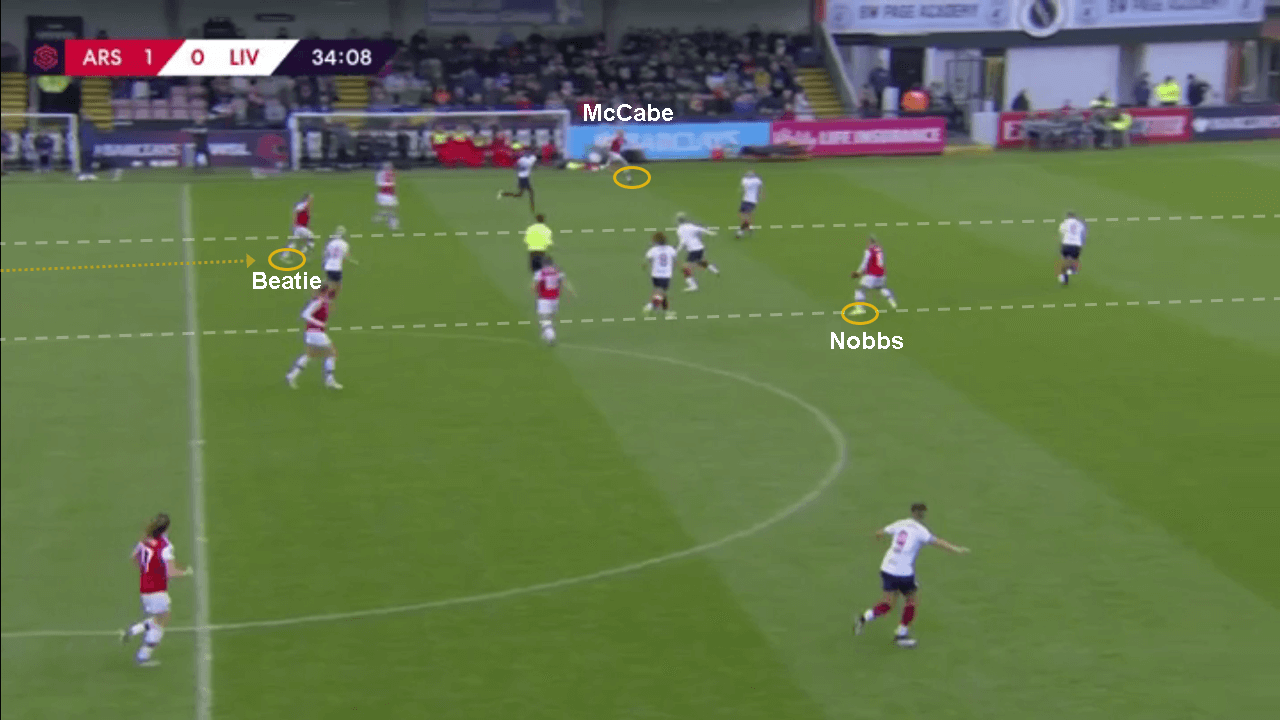
Arsenal’s goal began from a pass back from McCabe to Zinsberger. Instead of clearing it long, she finds a vertical pass to her centrehalf, Williamson. Williamson then drives forward and as she does so, Roord stays high and asks for the ball behind Bailey in the space. With another vertical pass, Williamson finds Roord who then plays it to Miedema. After beating through the entire Liverpool structure with vertical passes, Miedema finds herself in a 1v2 scenario against the centrehalves and scores with a small dribble to the right and pulling the trigger early. Thus we see how the goal was created from vertical passing, intelligent positioning and courage to play the short penetrative passes.
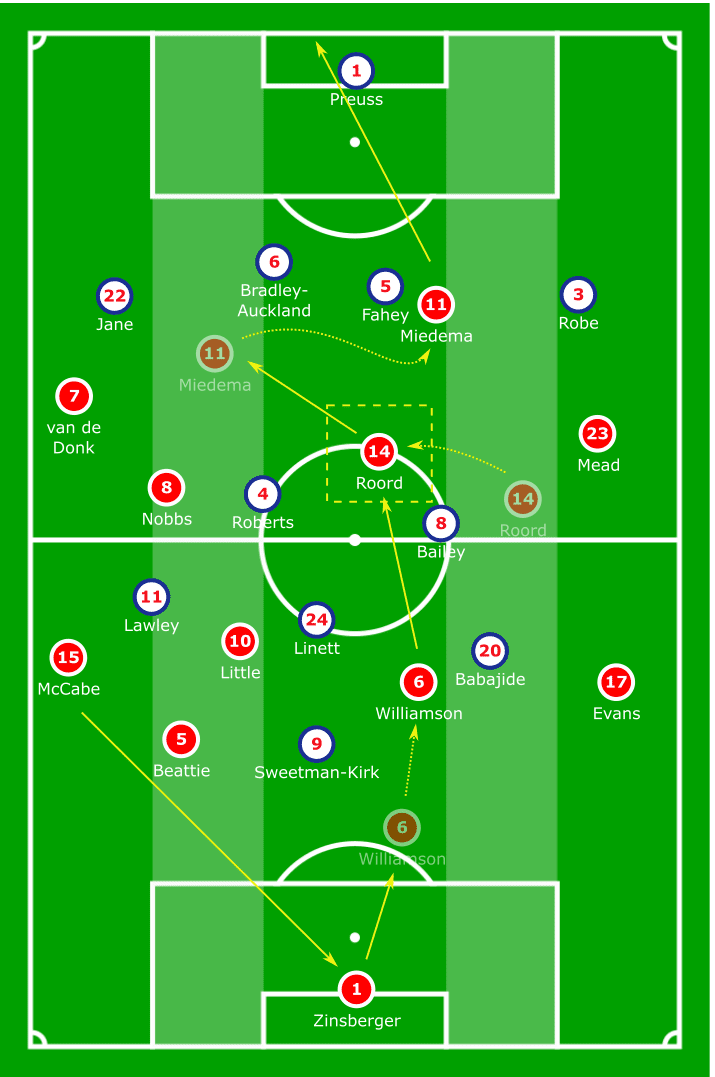
Well, if it was this simple, why couldn’t have Arsenal scored more? This is a good question because the score line doesn’t truly reflect upon Arsenal’s control of the game. There were a couple of reasons for this. Firstly, although Miedema’s goal is what earned the hosts the victory, she was struggling with her touches during this game. In the second half, van de Donk was moved to the right and Mead to the left. From this change, Evans was no longer as threatening as she was in the first half, while Van de Donk also did not see as much of the ball.
Liverpool responded by sitting deeper than they did in the first half. They did not give Arsenal as much space to exploit and played the long ball to their forwards. By opting for a damage control strategy, Liverpool ensured the game was still open to a possible counter attack, but Arsenal’s patience in circulating the ball gave the visitors almost no chance to create opportunities to equalise.
Conclusion
The midfield trio of Little, Nobbs and Roord is a magical combination capable of wonders in the buildup. This, alongside ball playing central defenders, inverted wingers and fullbacks with great tactical awareness make the North London side an aesthetically pleasing side to watch in the FAWSL. However against teams like Chelsea and Man City who they are competing against for points, Arsenal will need to find a strategy to be more efficient in front of goal as they find themselves trailing in terms of goal difference.
Liverpool have struggled this season despite showing signs of improvement in certain departments like set pieces and transitions. They key is to be brave with the quality of players that they have and take risks in order for them to create chances. The side hasn’t managed to find the back of the net from open play this season which is alarming and is an issue that needs to be addressed soon to avoid risk of relegation.

If you love tactical analysis, then you’ll love the digital magazines from totalfootballanalysis.com – a guaranteed 100+ pages of pure tactical analysis covering topics from the Premier League, Serie A, La Liga, Bundesliga and many, many more. Buy your copy of the November issue for just ₤4.99 here




Comments